This site is supported by our readers. We may earn a commission, at no cost to you, if you purchase through links.
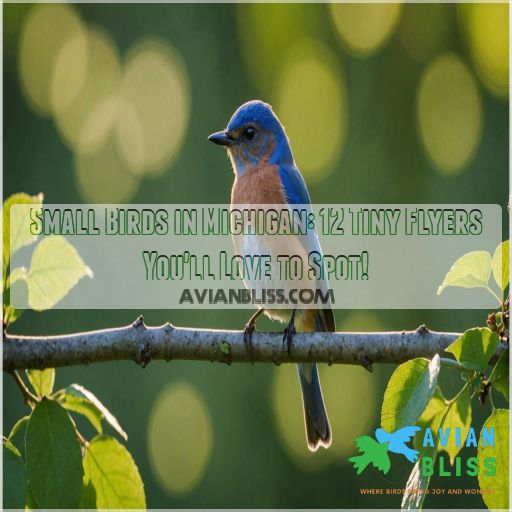
Keep your eyes peeled for the acrobatic black-capped chickadee, the jaunty tufted titmouse, and the upside-down-climbing white-breasted nuthatch.
In summer, you might spot a ruby-throated hummingbird zipping by or hear the sweet song of a yellow warbler.
Lucky birders could even glimpse the endangered Kirtland’s warbler, Michigan’s rarest songbird.
These tiny flyers come in all shapes and sizes, each with unique habits and habitats.
Whether you’re a casual observer or a passionate birder, Michigan’s small birds offer a world of wonder right outside your window.
Table Of Contents
- Key Takeaways
- Common Small Birds in Michigan Backyards
- Identifying Small Birds by Size and Shape
- Small Migratory Birds in Michigan
- Rare and Endangered Small Birds in Michigan
- Habitat Preferences of Michigan’s Small Birds
- Feeding Habits of Small Michigan Birds
- Nesting Behaviors of Small Michigan Birds
- Attracting Small Birds to Michigan Backyards
- Conservation Efforts for Small Michigan Birds
- Frequently Asked Questions (FAQs)
- How do I identify a bird in my yard?
- What are the really small birds called?
- How do small birds survive Michigans harsh winters?
- Which small birds have the most unique vocalizations?
- What are the smallest bird species in Michigan?
- How fast can Michigans small birds fly?
- Do small birds in Michigan have predators?
- Conclusion
Key Takeaways
- You’ll find a delightful array of tiny feathered friends in your backyard, from the acrobatic black-capped chickadee to the striking American goldfinch. These pint-sized wonders will have you reaching for your binoculars faster than you can say "tweet tweet!"
- Michigan’s diverse habitats are a bird-watcher’s paradise. Whether you’re exploring coniferous forests, wetlands, or prairies, you’ll encounter unique species adapted to each environment. It’s like a feathered treasure hunt across the Great Lakes State!
- You can play a crucial role in bird conservation by creating a backyard oasis. Plant native species, set up diverse feeders, and provide water sources – it’s like rolling out the red carpet for your avian neighbors. Who knew being a bird landlord could be so rewarding?
- Don’t let their size fool you – these tiny birds are tough cookies. They’ve got clever tricks up their feathered sleeves to survive Michigan’s harsh winters, from lowering their body temperature to stashing food like little feathered preppers. Talk about small but mighty!
Common Small Birds in Michigan Backyards
You’re about to discover the delightful world of Michigan’s backyard birds, where tiny feathered friends bring life and color to your outdoor spaces and learn about the birds that call Michigan home.
From the cheerful Black-capped Chickadee to the striking American Goldfinch, these small wonders will have you reaching for your binoculars in no time.
Black-capped Chickadee
You’ll often spot the charismatic Black-capped Chickadee in your yard. These tiny acrobats are masters of winter survival.
Tufted Titmouse
Next up on our backyard bird tour, let’s meet the charming Tufted Titmouse.
This little dynamo:
- Sports a jaunty crest
- Boasts a gray coat
- Flashes rusty flanks
- Sings a cheerful "peter-peter-peter
White-breasted Nuthatch
After the titmouse’s antics, let’s meet the acrobatic White-breasted Nuthatch! This tiny tree-climber’s got some serious skills:
| Nuthatch Trait | Fun Fact |
|---|---|
| Upside-down Pro | Can walk headfirst down tree trunks |
| Vocal Virtuoso | Makes a distinctive "yank-yank" call |
| Seed Stasher | Caches food for winter in tree bark |
Downy Woodpecker
While roaming your backyard, you might spot the pint-sized Downy Woodpecker, Michigan’s smallest woodpecker species. It’s a real charmer!
House Finch
You’ll often spot House Finches at your feeder. These social, rosy-red birds love sunflower seeds and have a cheerful warble.
American Goldfinch
Shifting gears from finches, let’s talk about the American Goldfinch. These vibrant yellow birds are real showstoppers in Michigan backyards!
Identifying Small Birds by Size and Shape
Now that you’re familiar with common backyard visitors, let’s get into the art of bird identification. Spotting a tiny flyer is exciting, but figuring out what it is can be tricky. Don’t worry, though – we’ve got some nifty tricks up our sleeve!
Think of it as a feathered puzzle, where each piece reveals more about your mystery bird. From the petite chickadee to the robust blue jay, size is your first clue.
Then, zero in on those distinctive features: Is the bill short and stout or long and slender? Does the tail fan out or stay slim? By honing your observation skills, you’ll soon be naming birds like a pro!
Small Migratory Birds in Michigan
You’re in for a treat as Michigan’s skies come alive with small migratory birds each year, like the vibrant Baltimore Oriole.
From the tiny Ruby-throated Hummingbird to the colorful Yellow Warbler, these feathered travelers will captivate you with their unique behaviors and stunning plumage.
Ruby-throated Hummingbird
Everyone’s favorite tiny acrobat, the Ruby-throated Hummingbird, brings a splash of iridescent magic to Michigan’s summers.
These pint-sized marvels:
- Migrate 500+ miles non-stop
- Beat wings 50 times per second
- Consume half their weight in nectar daily
- Build walnut-sized nests using spider silk
Yellow Warbler
You’ve met the hummingbird, now let’s chat about the Yellow Warbler! This bright little songster brings spring to life.
| Feature | Description | Fun Fact |
|---|---|---|
| Color | Sunny yellow | Males have rusty streaks |
| Song | "Sweet-sweet-sweet-sweeter-than-sweet" | They sing up to 3,240 times a day! |
| Diet | Insects, berries | They catch bugs mid-air |
Pine Siskin
The Pine Siskin, a small but mighty migrant, might surprise you with its hardy nature. Here’s what to know:
- Distinctive yellow wing bars
- Conical bill perfect for seed-cracking
- Nomadic behavior, following food sources
- Fond of conifer seeds and thistle feeders
- Melodious, buzzy song with rising "zreeee" notes
Dark-eyed Junco
Spotting a Dark-eyed Junco in Michigan’s winter? Look for a plump, grayish bird with a white belly, hopping around your snowy yard.
Common Redpoll
Redpoll magic descends on Michigan each winter. These tiny, rosy-cheeked visitors brave harsh conditions, flocking to your feeders for nyjer seeds and sunflower hearts.
Rare and Endangered Small Birds in Michigan
You’re about to discover some of Michigan’s rarest feathered treasures.
While these tiny birds might be hard to spot, learning about their unique characteristics and habitats will make your next birdwatching adventure even more exciting.
Kirtland’s Warbler
You’ve just encountered Michigan’s rarest songbird! Kirtland’s Warbler, once on the brink of extinction, now thrives in young jack pine forests. Its comeback story will warm your heart.
Piping Plover
With its distinctive sandy-colored plumage, the endangered Piping Plover’s a rare sight on Michigan’s beaches. You’ll need sharp eyes to spot this tiny shorebird scurrying along the water’s edge!
Cerulean Warbler
The elusive Cerulean Warbler, with its sky-blue plumage, faces dwindling numbers in Michigan’s deciduous forests.
Listen for its buzzy song and keep your eyes peeled high in the canopy for this rare gem.
Golden-winged Warbler
Have you ever spotted the elusive Golden-winged Warbler? This rare beauty faces serious threats in Michigan.
Its striking appearance evokes:
- Awe at nature’s artistry
- Concern for its survival
- Determination to protect it
Habitat Preferences of Michigan’s Small Birds
You’ll find Michigan’s small birds in a variety of habitats, each suited to their unique needs.
From the coniferous forests of the Upper Peninsula to the grasslands of the south, these tiny flyers have adapted to thrive in specific environments that provide them with food, shelter, and nesting opportunities.
Coniferous Forest Species
Needle-lovers unite! You’ll find a charming array of small birds thriving in Michigan’s coniferous forests. Let’s explore some of these tiny flyers and their unique adaptations:
| Species | Conifer Adaptations | Unique Traits |
|---|---|---|
| Spruce Grouse | Camouflaged plumage | Walks on snow |
| Red Crossbill | Specialized bill | Nomadic lifestyle |
| Pine Siskin | Conifer seed expert | Irruptive migrations |
Deciduous Forest Species
Shifting from pines to oaks, you’ll find a whole new cast of feathered friends. Deciduous forests burst with life, offering leafy hideaways and bountiful food sources for tiny migrants and year-round residents.
Wetland and Riparian Species
Head into Michigan’s watery wonderlands and you’ll find a treasure trove of tiny wetland dwellers. These feathered friends thrive in soggy spots, including:
- Swamp Sparrow
- Marsh Wren
- Common Yellowthroat
Grassland and Prairie Species
After exploring wetland warblers, let’s venture into Michigan’s open spaces. You’ll find a whole new cast of feathered friends in our grasslands and prairies. Ready for some wide-open birding?
Feeding Habits of Small Michigan Birds
You’ll be amazed by the diverse feeding habits of Michigan’s small birds.
From seed-crunching finches to nectar-sipping hummingbirds, these tiny flyers have adapted to a wide range of food sources that’ll keep you entertained at your backyard feeder.
Seed-eaters
You’ll find many seed-eaters among Michigan’s tiny flyers. These birds, like chickadees and finches, love feasting on sunflower seeds, millet, and nyjer. They’re masters at cracking open nature’s snack packs!
Insectivores
Michigan’s insectivores gobble up bugs like there’s no tomorrow!
These feathered friends feast on moths, beetles, and mosquitoes, keeping your backyard pest-free while putting on an acrobatic show.
It’s nature’s pest control!
Nectar-feeders
While insect-eaters buzz about, let’s flutter over to the sweet world of nectar-feeders! These tiny sippers bring a splash of color to your yard.
Here’s what you need to know:
- Ruby-throated hummingbirds: Michigan’s sole breeding hummingbird species
- Orioles: Occasional nectar-drinkers with a sweet tooth
- Nectar recipe: Mix 1 part white sugar to 4 parts water (no red dye!)
- Feeder placement: Hang in partial shade, away from windows
Omnivores
Many small Michigan birds are versatile eaters, adapting their diets with the seasons.
They’ll snatch up insects in summer, then switch to seeds and berries when winter rolls around.
Smart little foragers!
Nesting Behaviors of Small Michigan Birds
You’re in for a treat as we explore the fascinating nesting habits of Michigan’s tiny feathered friends.
From cozy cavities to intricate open-cup nests, these small birds showcase a remarkable array of architectural skills that’ll make you appreciate their ingenuity even more.
Cavity Nesters
You’ll find cavity nesters tucked away in tree hollows and crevices. These clever birds, like chickadees and nuthatches, adapt to natural holes or man-made nest boxes for their cozy homes.
Open-cup Nesters
Open-cup nesters are the daredevils of the bird world. These brave little architects build their homes right out in the open, facing numerous challenges:
- Battling wind and rain to keep their nests intact
- Playing hide-and-seek with hungry predators
- Carefully selecting the perfect spot for maximum camouflage
- Gathering nature’s finest materials for a cozy nursery
Ground Nesters
While some birds build nests high in trees, ground nesters face unique challenges. These brave little birds adapt to life on the forest floor, grasslands, or shorelines.
| Species | Habitat | Nesting Strategy |
|---|---|---|
| Ovenbird | Forests | Domed nest |
| Killdeer | Open areas | Scrape |
| Eastern Towhee | Shrubby areas | Cup nest |
| Vesper Sparrow | Grasslands | Hidden in grass |
| Common Nighthawk | Various | Bare ground |
Nest Box Preferences
After discussing ground nesters, let’s explore nest box preferences.
Many small Michigan birds adore cozy homes you provide.
Chickadees, nuthatches, and titmice readily move into well-placed boxes.
It’s like bird real estate!
Attracting Small Birds to Michigan Backyards
Want to turn your Michigan backyard into a bustling hub for tiny feathered friends?
From choosing native plants to setting up the perfect feeder buffet,
we’ll show you how to create an irresistible haven that’ll have small birds flocking to your yard faster than you can say "chickadee-dee-dee.
Native Plant Selection
To create a bird paradise in your backyard, embrace native plants.
They’re like a buffet for our feathered friends!
Michigan’s vibrant flora offers a smorgasbord of berries, seeds, and insects year-round.
Types of Bird Feeders
You’ve planted native flora, now let’s talk feeders! Attract Michigan’s tiniest birds with these feeder types: check out this guide to Michigan’s yellow birds
- Tube feeders for finches
- Platform feeders for chickadees
- Nyjer feeders for siskins
- Suet cages for nuthatches
Water Sources
Water’s not just for the birds, but it’s a surefire way to attract them! Let’s explore how to create a backyard oasis for our feathered friends:
| Water Source | Pros | Cons |
|---|---|---|
| Bird Bath | Easy to maintain | Needs regular cleaning |
| Mini Pond | Natural habitat | Requires more space |
| Dripping Fountain | Attracts with sound | Higher initial cost |
Creating Shelter and Cover
Shelter is the cozy retreat every bird dreams of! Create a bird paradise in your backyard with these inviting options:
- Birdhouses with species-specific designs
- Brush piles for ground-dwellers
- Dense native shrubs for nesting
- Evergreens for year-round cover
Conservation Efforts for Small Michigan Birds
You can play a key role in protecting Michigan’s small birds through various conservation efforts.
From participating in citizen science programs to supporting habitat restoration projects, there are many ways to make a positive impact on these tiny flyers’ futures.
Habitat Restoration Projects
Beyond your backyard, Michigan’s small birds need help on a larger scale. Habitat restoration projects are breathing new life into degraded areas, giving our feathered friends a fighting chance.
Citizen Science Programs
Want to make a difference? Citizen science programs let you contribute to bird conservation while enjoying your hobby.
Try using birdwatching apps to collect data for projects that shape important research.
You’ll feel connected and impactful!
Bird-friendly Building Practices
How can we make our buildings safer for Michigan’s feathered friends? By adopting bird-friendly practices, you’ll be giving these tiny flyers a fighting chance.
Here are four key strategies:
- Install bird-friendly windows
- Create green roofs
- Use sustainable materials
- Reduce light pollution
Invasive Species Management
Invasive species threaten Michigan’s small birds.
You can help combat them.
Here’s a quick guide to common invaders and how to manage them:
| Invasive Species | Impact on Birds | Management Strategy |
|---|---|---|
| Garlic Mustard | Outcompetes native plants | Hand-pull or herbicide |
| European Starling | Nest cavity competition | Use excluder-style nest boxes |
| Feral Cats | Direct predation | Keep cats indoors, support TNR programs |
Frequently Asked Questions (FAQs)
How do I identify a bird in my yard?
Grab your binoculars and a field guide!
Look closely at the bird’s size, shape, colors, and markings.
Listen for distinctive calls or songs.
You’ll become a backyard Sherlock Holmes in no time, cracking avian mysteries!
What are the really small birds called?
Imagine spotting a tiny feathered friend darting around your feeder.
You’re likely seeing a chickadee or finch.
These pint-sized powerhouses, often called "songbirds," include warblers, nuthatches, and wrens.
They’re nature’s pocket-sized wonders, full of personality and charm.
How do small birds survive Michigans harsh winters?
You’d be amazed at these tiny survivors!
They puff up their feathers for insulation, huddle together for warmth, and even lower their body temperature at night.
Some crafty critters stash food for those frosty days ahead.
Which small birds have the most unique vocalizations?
In a symphony that’d make Mozart’s ears melt, the Black-capped Chickadee’s "fee-bee" song and the American Goldfinch’s "potato-chip" call stand out.
You’ll also love the White-throated Sparrow’s "Oh-sweet-Canada" whistle and the Hermit Thrush’s ethereal flute-like song.
What are the smallest bird species in Michigan?
You’ll find Michigan’s tiniest feathered friends in the hummingbird family.
The Ruby-throated Hummingbird, weighing just 3 grams, takes the cake!
Other pint-sized pals include the Golden-crowned Kinglet and Winter Wren, both under 6 grams.
How fast can Michigans small birds fly?
Small birds can zip through the air at impressive speeds! Hummingbirds, the speedsters of the bunch, can reach up to 60 mph in a dive. Most songbirds cruise around 20-30 mph, but they’re no slouches when chasing insects!
Do small birds in Michigan have predators?
Picture a chickadee’s narrow escape from a swift Cooper’s hawk!
Yes, these little birds face numerous predators.
Cats, larger birds, and even some mammals pose threats.
They’ve developed keen instincts and agility to survive nature’s challenges.
Conclusion
You might think spotting small birds in Michigan is challenging, but it’s easier than you’d expect!
From common backyard visitors to rare warblers, these tiny flyers offer endless delight.
Whether you’re setting up feeders, planting native species, or venturing into Michigan’s diverse habitats, you’re sure to encounter fascinating small birds.
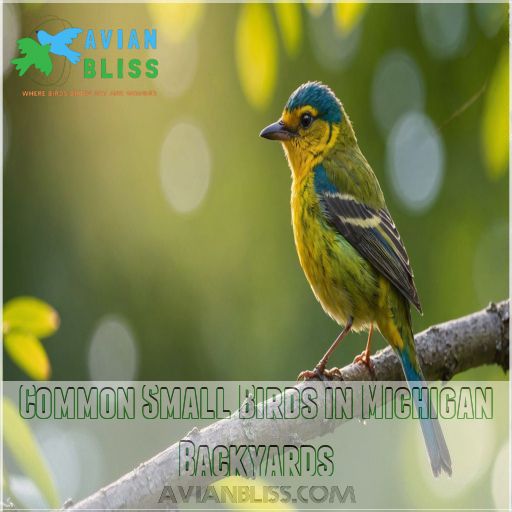


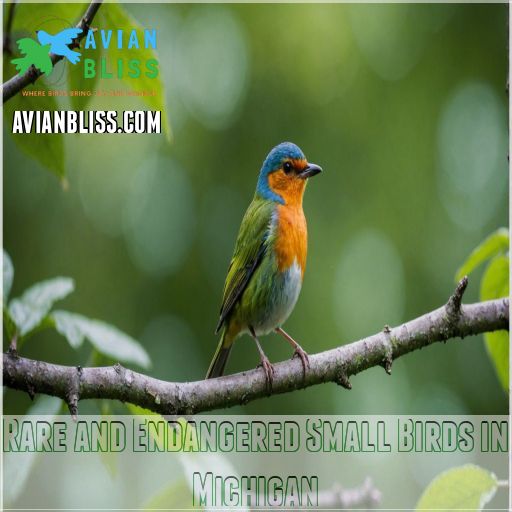
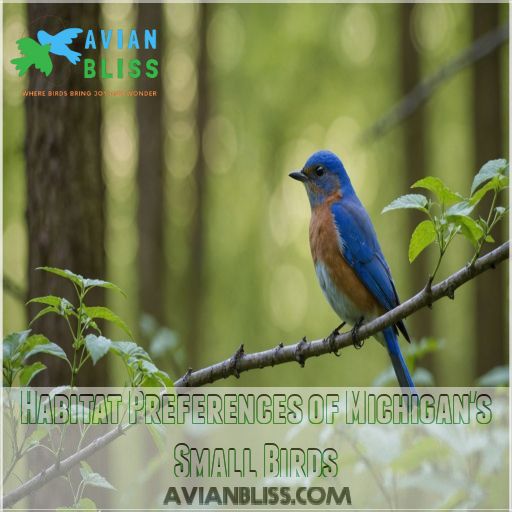
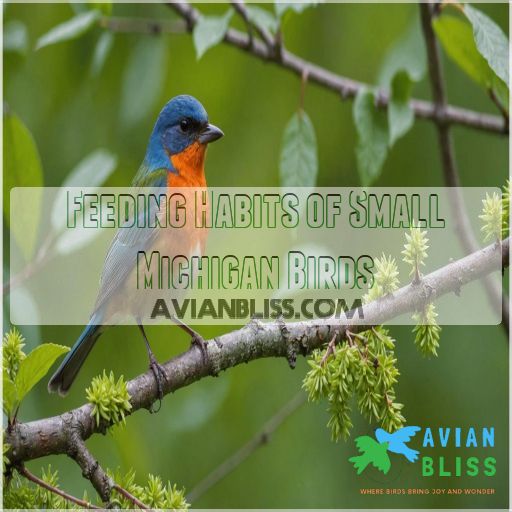
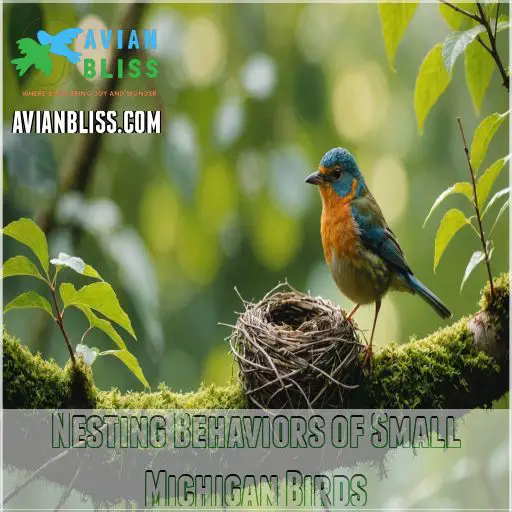
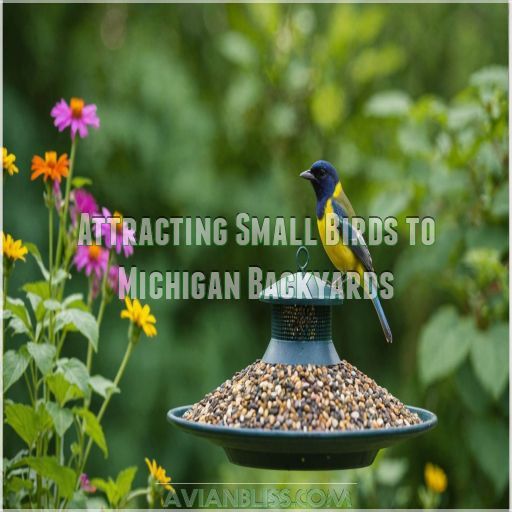
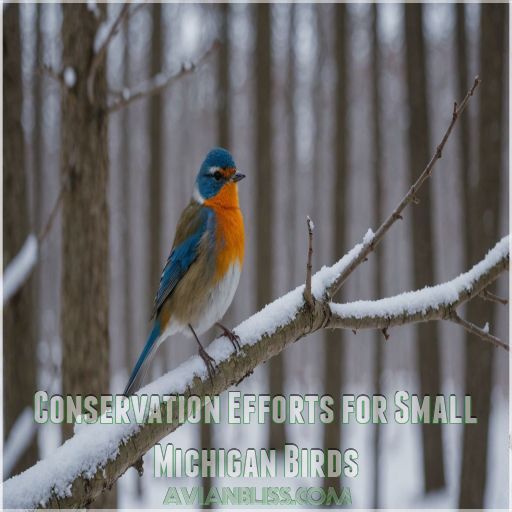
0 Comments